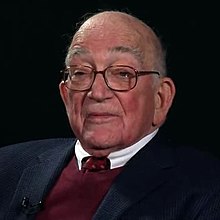Sidney Drell | |
|---|---|
 | |
| Born | September 13, 1926 |
| Died | December 21, 2016 (aged 90) Palo Alto, California, U.S. |
| Nationality | American |
| Alma mater | Princeton University University of Illinois |
| Known for | Drell–Yan process |
| Children | 3, including Persis[1] |
| Awards | E. O. Lawrence Award (1972) Pomeranchuk Prize (1998) Enrico Fermi Award (2000) Heinz Award for Public Policy (2005) National Medal of Science (2011) |
| Scientific career | |
| Fields | Physics |
| Institutions | Stanford Linear Accelerator Center |
| Thesis | Part I Magnetic internal conversion coefficient Part II Electrostatic scattering of neutrons Part III Anomalous magnetic moments of nucleons (1949) |
| Doctoral advisor | Sidney Dancoff |
| Doctoral students | James Bjorken Steven Frautschi Roscoe Giles Robert Jaffe Heinz Pagels Joel Primack |
Sidney David Drell (September 13, 1926 – December 21, 2016) was an American theoretical physicist[2] and arms control expert.[3]
At the time of his death, he was professor emeritus at the Stanford Linear Accelerator Center (SLAC) and senior fellow at Stanford University's Hoover Institution. Drell was a noted contributor in the fields of quantum electrodynamics and high-energy particle physics. The Drell–Yan process, which was used to discover the Higgs boson, is partially named for him.[2]
- ^ Schudel, Matt (December 24, 2016). "Sidney Drell, physicist and arms-control expert, dies at 90". The Washington Post.
- ^ a b Jaffe, Robert; Jeanloz, Raymond (19 October 2019). "Sidney David Drell (September 13, 1926–December 21, 2016): A Biographical Memoir". Annual Review of Nuclear and Particle Science. 69 (1): 1–14. Bibcode:2019ARNPS..69....1J. doi:10.1146/annurev-nucl-020619-120837. ISSN 0163-8998. S2CID 209945149.
- ^ Cite error: The named reference
Kubotawas invoked but never defined (see the help page).